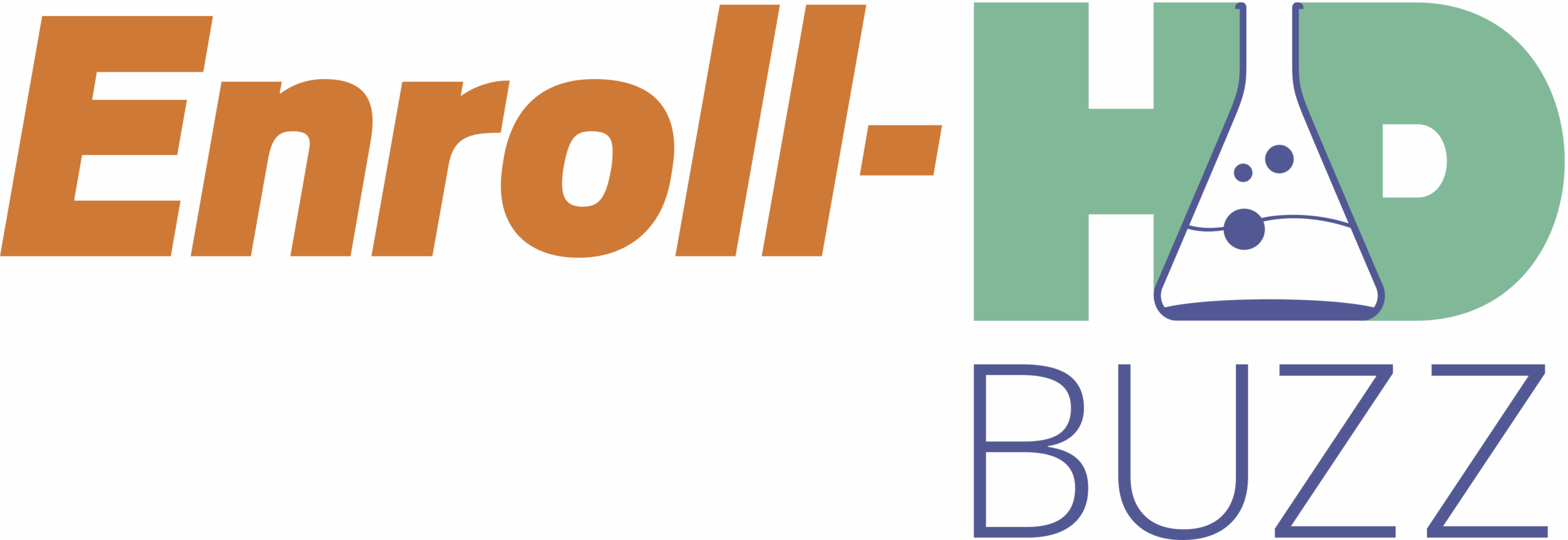
HDBuzz Enrolls in Enroll-HD
As promised, HDBuzz's Jeff Carroll finally signed up for the Enroll-HD study. Learn more about this important global HD "observational study" here.

The Enroll-HD study is the largest clinical study in Huntington’s Disease ever. What’s it all about, and why is Enroll-HD so important in the fight against HD? Join HDBuzz’s own Jeff Carroll as he joins the Enroll-HD study to learn more.
What is observational research?
In some ways, HD is very simple – if you inherit a mutant HD gene from either your mother or father, you will eventually develop symptoms of the disease, which can include movement changes as well as thinking and mood problems.
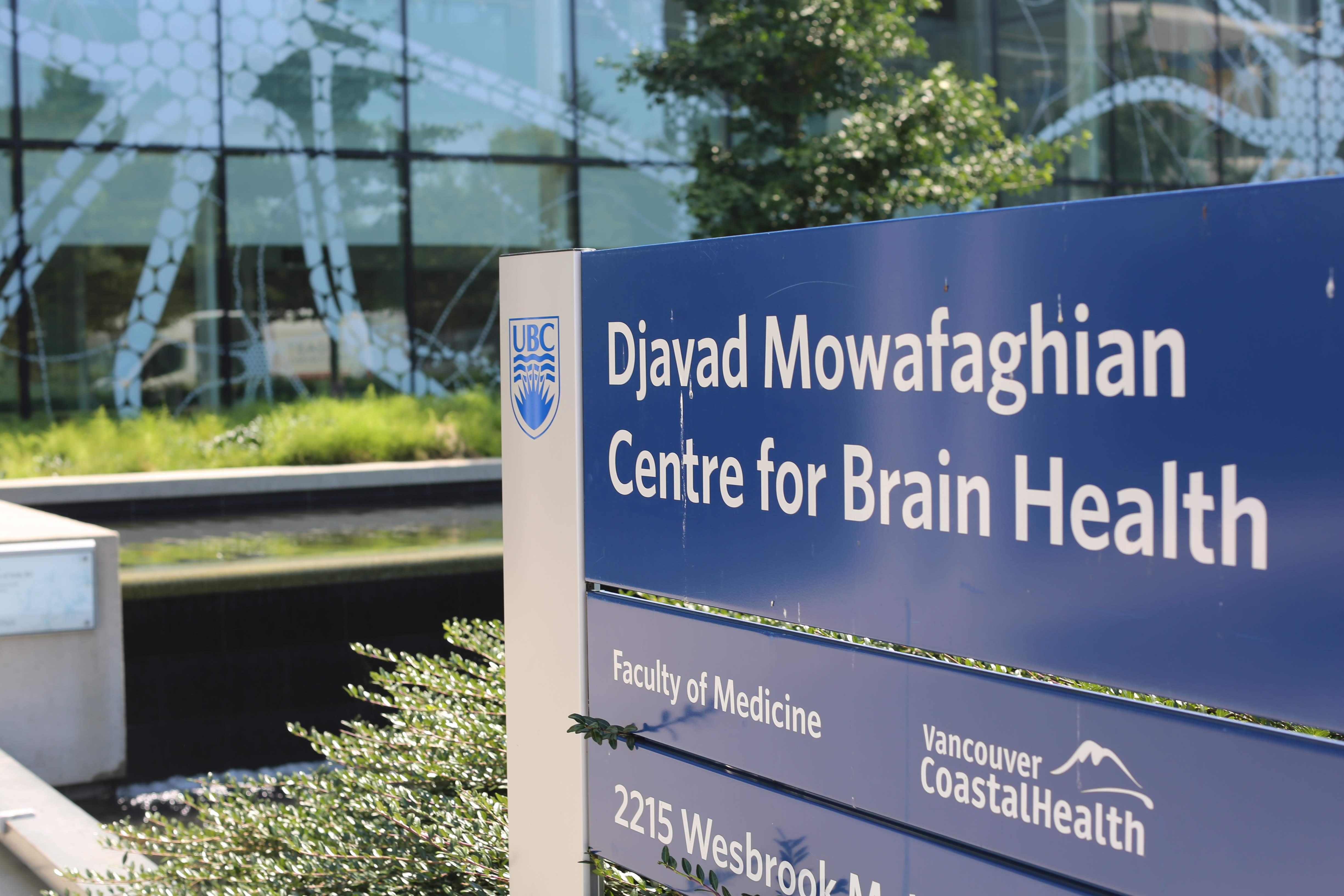
However, as every HD family knows, HD progresses very differently in each patient. This leaves researchers with important questions about the disease – why does it strike earlier in some people than others? What parts of the brain are involved in producing HD symptoms? Why is it that some HD patients have very severe movement problems, but quite clear thinking, while others seem to move normally but have explosive anger or irritability?
To answer these questions, researchers need to study, or observe HD patients. For every scientific experiment, researchers also need a control, or a comparison group. In the case of HD the best possible controls are people who did not inherit the HD mutation but live the same environment as people who did. For that reason, the ultimate control group for an HD study are the un-affected relatives of HD patients – their siblings, spouses and children who didn’t inherit the HD mutation.
Crucially, Enroll-HD is open to everyone from an HD family, even if they have not had genetic testing. Your genetic status will never be revealed to you or the staff at your site.
What is Enroll-HD?
To develop better treatments for HD, we need to understand it better using observational studies of HD families. Enter Enroll-HD – a worldwide observational study for Huntington’s disease families. Enroll-HD is sponsored by the CHDI foundation, a non-profit organization focused solely on speeding the development of new effective treatments for HD.
Enroll-HD began with the merger of a large European HD observational study (Registry) run by the European Huntington’s Disease Network with another run by the Huntington Study Group (COHORT). You can read more about the history of Enroll-HD in an early HDBuzz story here. Since its launch, Enroll-HD has grown enormously, and now includes more than 16,000 participants in North and South America, Europe and Australasia.
Studying the progression of HD in these volunteers allows researchers to understand the disease process in ever more fine detail. Dozens of research studies have already been published based on the data provided by the participants of Enroll-HD, examining everything from what effect blood pressure has on HD symptoms, to whether HIV-infection might alter the rate of progression of HD.
In a recent example, recently researchers from IBM and the CHDI Foundation conducted a sophisticated mathematical analysis of how specific HD symptoms change over time. IBM was able to bring its huge experience in artificial intelligence (remember Watson on Jeopardy?) to bear on HD. The involvement of these fantastic researchers shows that, if you build a really good data set, top-notch researchers will want to work with you to understand it.
Enroll-HD is sometimes referred to as a platform. What that means is that Enroll-HD is designed to work in such a way that other scientists can use the platform to answer their own questions. Because Enroll-HD has already gathered together a great group of HD family members, other researchers interested in HD progression don’t have to spend time finding people and bringing them into the clinic – they’re already there! These HD family members can then be invited to take part in these other research opportunities.
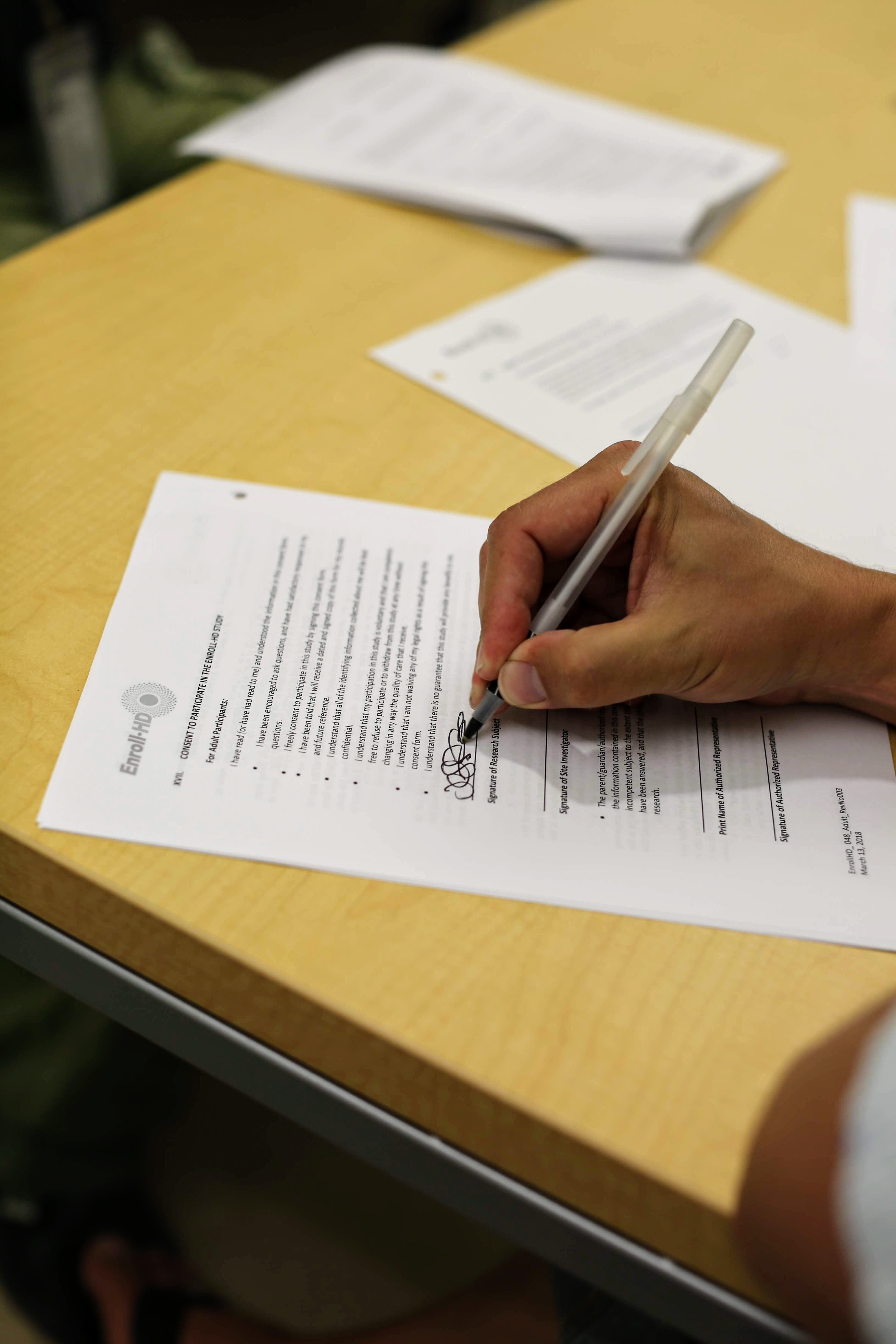
Enrolling HDBuzz
Your intrepid HDBuzz reporter – me, Jeff Carroll – is from an HD family, and has participated in a number of HD observational studies, but at the 2018 HDSA convention when Dr Ed Wild called for a show of hands of everyone who had taken part in Enroll, mine was not one of the many that was raised. I just never got round to it!
I agreed to remedy the situation by joining the Enroll-HD study at the first opportunity. Making an appointment with a clinic near me was easy. After reaching out to the clinic staff by email, I was instructed to come to the clinic on a recent Tuesday afternoon for my first, or baseline Enroll-HD visit. Because this is my first Enroll-HD visit, there’s a little extra information to collect from and explain to study participants.
Actually informed Consent
My appointment began with a very careful run through of the Enroll-HD consent form. Consent forms can be very boring and many of us just jump to the signature line and try to move on. But the Enroll-HD consent form is really clearly written and carefully explains things.
And think about it, since you’re donating potentially sensitive medical information and maybe even DNA, don’t you want to understand how it’s going to be used? Who’s going to keep track of it, and how will they ensure your samples and information are safe? The Enroll-HD consent form explains all these issues in plain language, and the staff helped by walking through the document with me.
Questions, questions, questions
Having signed the consent, we moved on to medical history, and a set of questionnaires that explain how I’ve been feeling recently, both mentally and physically. It might seem strange to describe health problems unrelated to HD – who cares about my blood pressure if we’re studying a brain disease like HD?
But actually researchers have found unexpected connections between a number of health and lifestyle factors and HD progression, so it’s really important that this kind of information be collected correctly, even if it seems irrelevant at the time.
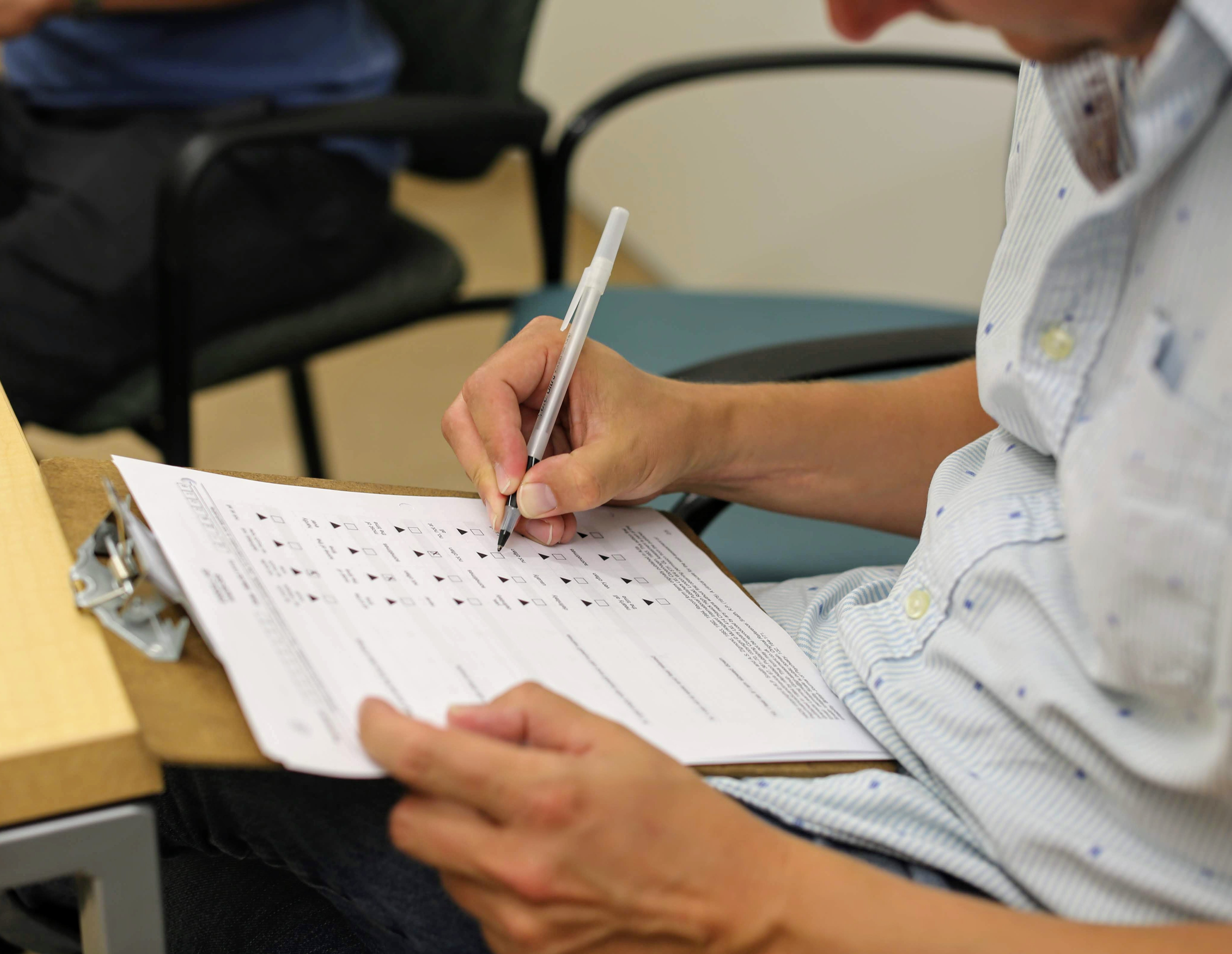
After completing those forms, I next underwent a brief set of cognitive, or thinking, tests. Having participated in the TRACK-HD study, which included dozens of these tests, I was pleasantly surprised to find that the Enroll-HD visit included only a few pen-and-paper based tests.
These included things like matching symbols to numbers, and also some verbal tests like listing how many members of a category I could recall in a short period. Like everyone who takes these tests, I felt really stupid most of the time! The staff helping me were kind and supportive and they were over before I could get too mad about the object I couldn’t remember (it was a giraffe, for the record). They also pointed out that the tests are designed to feel difficult for everyone, even if they have perfect thinking skills.
Seeing the doctor
After completing these brain teaser tests, next up was a formal neurological examination with Dr Blair Leavitt, one of the world’s best HD physicians and researchers. Dr Leavitt was very thorough and careful, watching me closely as I did some simple movements.
This was pretty simple stuff – like heel-to-toe walking, and alternating certain movements with my hands. Despite how simple these movements are, neurologists like Dr Leavitt are really good at picking out subtle – or not so subtle – changes that occur in HD and other diseases. Honestly, it was a little stressful to have someone watching you so carefully as you move, but Dr Leavitt was really friendly and supportive, and we got through the tasks without too much worry.
Interestingly, after doing my movement exam Dr Leavitt offered to discuss with me what he had seen. He explained that he wasn’t acting as my personal doctor at the moment, since this was a research visit, but that he was willing to share his impressions with me – if I wanted to hear them.
This surprised me, but I realized it was a great way to help HD family members get some expert insight into their condition while they participate in research. Most HD family members don’t get to see an expert like Dr Leavitt very often, and it’s great to use the opportunity to hear from one.
Blood – what is it good for?
The final part of my Enroll-HD visit was a voluntary blood sample donation. Don’t worry – if for some reason donating blood isn’t possible for you, you can still participate in Enroll-HD. But the blood samples, and particularly the DNA extracted from the blood, are a huge part of what Enroll-HD does for HD researchers. Some of the sample is tested for the HD mutation but the results are coded so the genetic status is unknown to you and the doctor. The rest of the sample is used to extract DNA and cell lines needed for HD research.
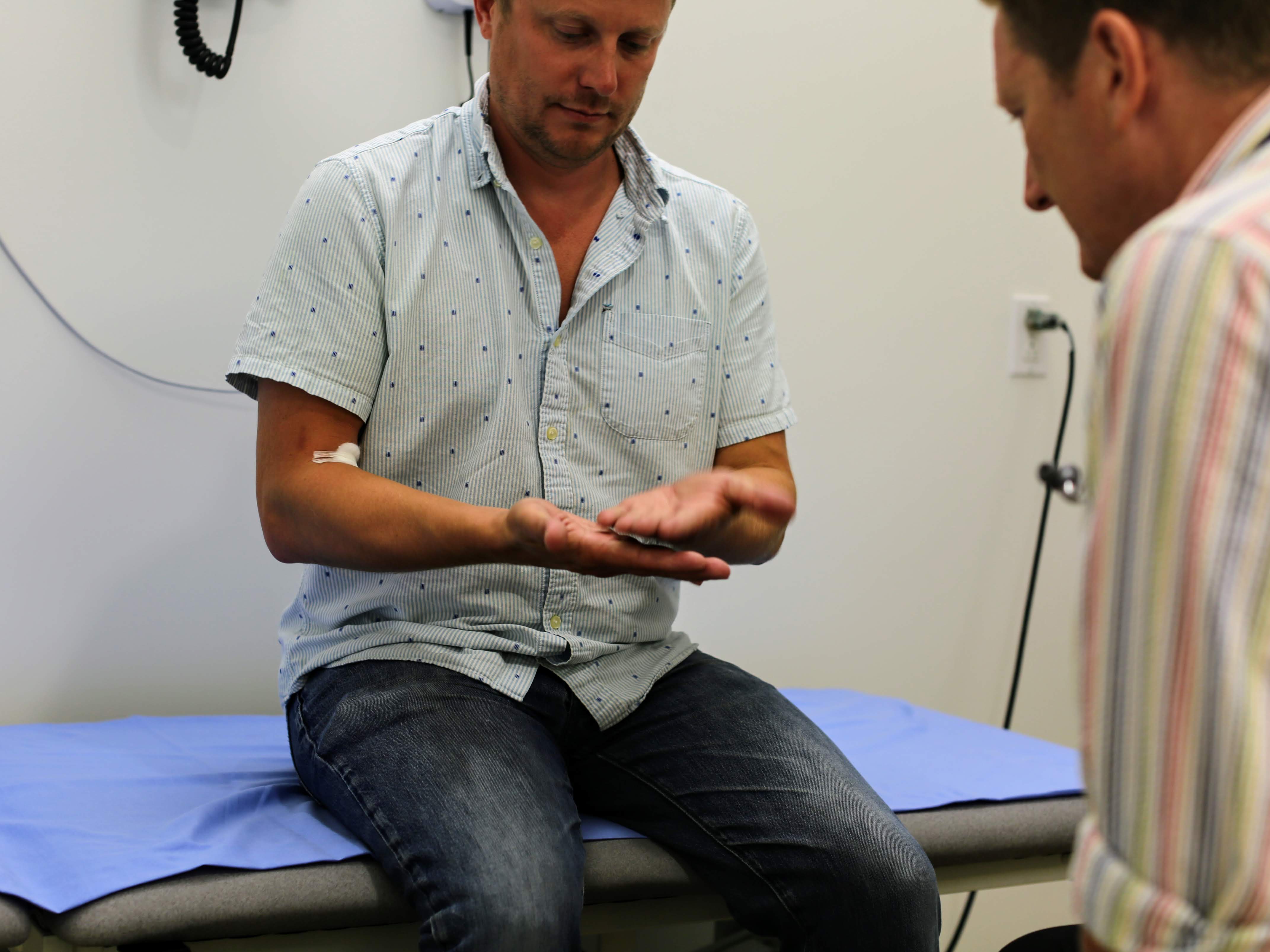
As a specific example, in 2016 HDBuzz reported on the results of a huge genetic screen of HD families that yielded really important new insights into what makes makes HD onset happen faster or slower.
That’s really important, but that kind of research takes literally thousands of HD samples, from families with as much genetic diversity as possible. According to researchers running this genome wide association study, the current version of the analysis includes more than 9,000 HD patient DNA samples!
Many of the 9,000 people who donated their DNA for research had no idea that new technologies would be developed that would enable brilliant researchers to do these kinds of analyses. That’s just what Enroll-HD is so well suited to do – to very carefully collect samples DNA, and with them a snapshot of how the person who donated it was feeling at the time.
We don’t know every way in which these samples will be used, because every month seems to bring a new way of analyzing or using DNA to better understand diseases like HD. So it’s really exciting to be able to donate blood and know that my DNA might be a tiny part of the solution to the problem of HD.
As I said above, Enroll-HD is a platform study. This just means that other researchers with specific interests are encouraged to use Enroll-HD’s group of HD family member volunteers to build their own studies. As an example, the UBC HD clinic is also running a study called HDClarity (full disclosure: the primary investigator of HDClarity is Dr Ed Wild, HDBuzz co-founder and editor-in-chief). HDClarity collects and studies cerebrospinal fluid – the clear fluid that bathes the brain and spinal cord – and how it changes in people with HD. At the UBC clinic, Enroll-HD participants are asked if they’d like to contribute to the HDClarity study by donating cerebrospinal fluid during their Enroll-HD visit.
See how Enroll-HD is a platform? The HDClarity investigators don’t have to go out and recruit their own volunteers, or collect DNA or other samples because they’re already there as part of the Enroll-HD visit. This is, potentially, one of the most important ways that Enroll-HD can grow and help us find HD treatments.
The trial squad
Enroll-HD is a platform in another sense, too – for clinical trial recruitment. When a new drug trial is about to start enlisting patients at a clinical site, the first thing the team will do is sit down and look at the Enroll-HD database, to compare people’s clinical state and other data against the trial criteria, to identify which Enroll participants might be suitable for the trial. It is never mandatory to be part of Enroll-HD in order to be in a clinical trial – but it is a very good way to get as high as possible up the list of people considered.
End of the day
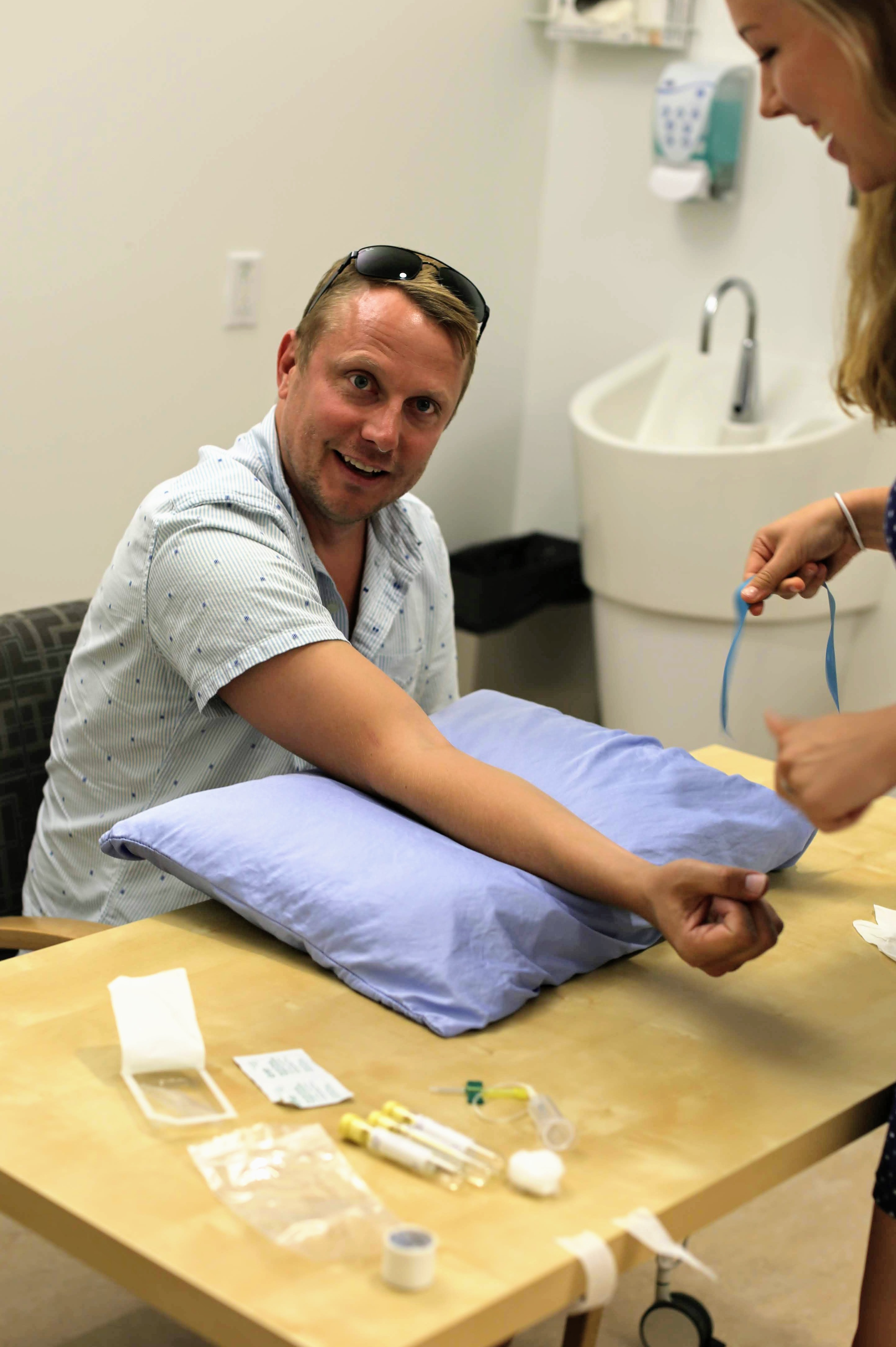
And, with that blood donation, my visit was done. I was reimbursed for my travel expenses, thanked by the clinic staff and headed out the door. The whole visit was done in a little over an hour and a half, and future visits could be even shorter.
So, should you do it? Participation in research has huge benefits for the broader HD community, and Enroll-HD is, without question, the most important way HD family members can participate.
But participation in Enroll-HD isn’t for everyone – maybe you don’t live near a site, or don’t feel comfortable enough with your role as an HD family member to participate. That’s absolutely fine – no one should feel compelled or forced to participate in research in any way. But, if you feel like you want to help, and live close enough to an Enroll-HD site to do it, this is an amazing way to get involved.
As for me, my appointment was definitely associated with a little bit of stress – it’s difficult to have a very skilled neurologist watch you move when you know you carry the mutant HD gene. What if he sees something? Other participants might have other sources of stress. What if some members of your family are not open about HD, and don’t want to hear about it from you? In that case, showing up and participating can require some courage and cause some potential family issues if they don’t want to deal with it.
Personally, the minor stresses and fears I experienced participating as an Enroll-HD volunteer were very small compared to the satisfaction I get from continuing to participate in research. It seems that 15,999 or so otherHD family members feel the same way, given how many folks are participating in Enroll-HD.
Take home
The road to effective treatments for HD requires we understand the disease, in all its complexity. Enroll-HD is the best way for most HD families to participate in research, and is open to every member of an HD family – whether they carry the mutant HD gene or not.
In HDBuzz’s opinion, if you’re from an HD family and you’re looking for one thing to do to help advance the cause – join Enroll-HD. If you spend the rest of the year blissfully ignoring HD (except for reading HDBuzz, of course), know that you’ll be a huge part of the solution if you volunteer your time to help all of us understand HD better.
Stay tuned to HDBuzz for more exciting results from the Enroll-HD study.
Learn more
For more information about our disclosure policy see our FAQ…


